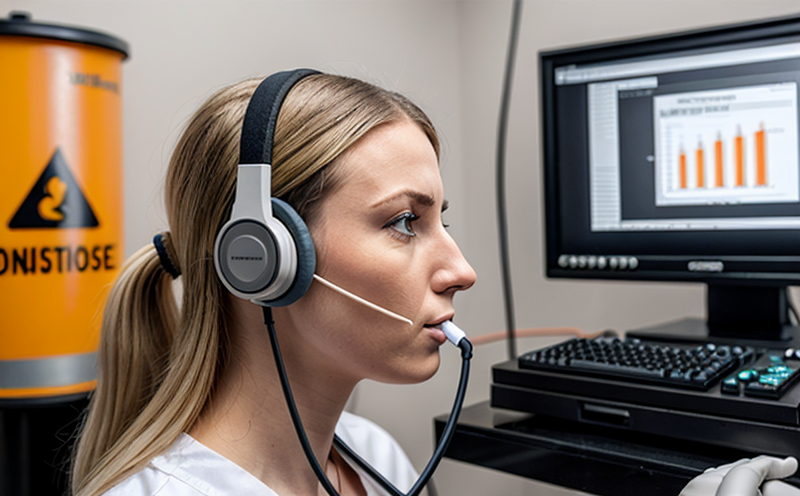ISO 8253-1 Audiometric Test Methods for Hearing Conservation
The ISO 8253-1 standard defines audiometric test methods that are essential for hearing conservation programs. These methods provide a structured approach to identifying, monitoring, and controlling occupational noise exposure, ensuring compliance with international health and safety regulations.
Occupational noise is one of the leading causes of work-related hearing loss globally, affecting millions of workers in various sectors including manufacturing, construction, mining, and transportation. The ISO 8253-1 standard helps employers implement effective audiometric testing programs to protect employees from hearing damage caused by excessive noise exposure.
The primary objective of this service is to provide comprehensive audiometric testing services that comply with the strict requirements outlined in ISO 8253-1, ensuring accurate and reliable data for hearing conservation. This service includes a range of activities such as:
- Preparation of test environments according to ISO standards.
- Conducting pure-tone audiometry tests using calibrated audiometers.
- Recording and analyzing test results in accordance with the standard.
- Detailed reporting that meets regulatory requirements.
The testing process involves several key steps:
- Initial Hearing Test: The first step is to establish a baseline audiogram for each employee. This includes conducting pure-tone air-conduction and bone-conduction audiometry tests, with the results recorded in an audiometric test report (ATR).
- Subsequent Testing: Employees are tested at regular intervals as specified by the hearing conservation program. These follow-up tests help monitor changes in hearing over time.
- Medical Review: Based on the test results, medical reviews may be conducted to determine if further action is needed.
- Data Analysis and Reporting: The collected data are analyzed for trends and patterns that could indicate potential issues. This information is then compiled into a comprehensive report for management review.
The ISO 8253-1 standard ensures that audiometric testing is conducted in a consistent, standardized manner across different environments and organizations. This consistency is crucial for accurate comparisons over time and between different populations, which is particularly important in occupational health contexts where long-term monitoring is essential.
| Test Parameters | Description | Acceptance Criteria |
|---|---|---|
| Pure-tone air-conduction audiometry | The method used to assess hearing sensitivity by measuring the lowest intensity at which tones can be heard. | Results must fall within specified thresholds for each frequency and level. |
| Bone-conduction audiometry | A method that measures hearing sensitivity using a bone vibrator instead of earphones. | The results should not differ significantly from the air-conduction tests. |
| Speech reception thresholds | Determines the softest level at which speech sounds can be heard and understood. | Thresholds must meet specific criteria to ensure accurate measurement of hearing sensitivity. |
The service provided by our laboratory is designed to help employers comply with international standards, ensuring that their audiometric testing programs are up-to-date and effective. By adhering to the ISO 8253-1 standard, organizations can demonstrate their commitment to employee health and safety while also meeting regulatory requirements.
Why It Matters
Occupational noise exposure is a significant occupational hazard that can lead to permanent hearing loss. The ISO 8253-1 audiometric test methods play a crucial role in preventing this by providing accurate and reliable data on employees' hearing status.
The importance of these tests cannot be overstated, as they:
- Help identify workers at risk of hearing damage early.
- Enable employers to take proactive measures to reduce noise exposure.
- Ensure that exposed workers receive appropriate hearing protection devices (HPDs).
- Provide a clear picture of the effectiveness of existing hearing conservation programs.
The data collected through these tests are critical for making informed decisions about workplace safety and health. By identifying at-risk employees early, employers can implement targeted interventions to protect them from further damage.
The ISO 8253-1 standard is particularly important because it provides a consistent framework for audiometric testing across different organizations and countries. This consistency ensures that the data collected are comparable and reliable, which is essential for effective hearing conservation programs.
International Acceptance and Recognition
The ISO 8253-1 standard is widely recognized and accepted globally due to its rigorous testing methods and comprehensive approach. The standard has been adopted by numerous countries and organizations, including:
- Australia: AS/NZS 1269.4
- New Zealand: AS/NZS 1269.4
- Canada: CSA Z107.5
- The United Kingdom: BS EN ISO 8253-1
- The European Union: EU Directive on Occupational Exposure to Noise (2003/10/H)
The widespread acceptance of the ISO 8253-1 standard is a testament to its effectiveness and reliability. It has been adopted by many countries, including those with different regulatory frameworks.
Use Cases and Application Examples
| Industry Sector | Description of Use Case |
|---|---|
| Manufacturing | A manufacturer in the automotive industry uses ISO 8253-1 to monitor noise exposure levels and ensure compliance with local regulations. |
| Mining | A mining company conducts regular audiometric testing of its underground workers to protect them from excessive noise exposure. |
| Construction | A construction firm uses ISO 8253-1 to evaluate the effectiveness of its hearing protection devices and implement improvements where necessary. |
| Tourism | A hotel chain employs ISO 8253-1 to monitor noise levels in guest rooms and public areas, ensuring a safe and comfortable environment for guests. |
The application of the ISO 8253-1 standard is not limited to specific industries. It can be used in any organization where there is a need to monitor occupational noise exposure and implement effective hearing conservation programs.





